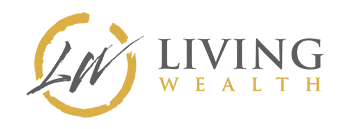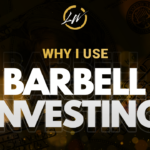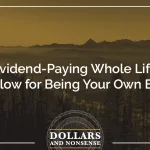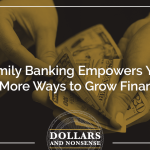In this “Money in Motion” episode, we discuss how keeping money in motion is better to build wealth than conventional wisdom. The convention focuses on storing money up in accounts for decades without ever getting your hands on it. Instead, we say put your money to work today; maybe even make it get a second or third job.
Today, we’re going to talk about the concept that motion is a crucial way to build wealth. This model of growing your money is a little different from what we’ve all been taught.
For those of you who are new to IBC, you can probably tell many things we suggest and do are different from conventional advice. To that point, one of the biggest things is the difference between people who let money lay dormant and people who keep their money in motion. People practicing IBC put their money to work for them, while folks operating under conventional thinking let their money be lazy.
Keeping Money in Motion Topics Discussed:
- What keeping money moving means
- Why and how static money storage robs you of wealth
- How motion means more than policy loans
- What this means for retirement accounts and cashflow
- What it means to really put your money to work or even do multiple jobs
- Lesson’s from Robert Kiyosaki’s book titled Rich Dad Poor Dad about money
- Understanding what banks have known for hundreds of years about money in motion
- What it means to be your own banker
Money in Motion Episode Resources:
- Gain access to our Secret Banking Masterclass now FREE to listeners of the podcast here now
- What is Infinite Banking
- Who was Nelson Nash?
- Robert Kiyosaki
- CREDIT: Episode art background photo by Jonathan Chng
Episode 138 Transcript: Why People Who Keep Money in Motion Grow Wealth Faster
Nate: In this episode, we discussed how keeping money in motion is a better way to build wealth than the conventional wisdom that focuses on storing money up in accounts for decades without ever getting your hands on it. She’s Holly and she helps people find financial freedom.
Holly: He’s Nate. He makes sense out of money. This is Dollars and Nonsense. If you follow the herd, you will be slaughtered.
Nate: Hi. Well, welcome back to the show, everyone. We’re so glad you decided to tune in and listen to us. We’re really just grateful for the following that’s been build for the Dollars and Nonsense show, really just excited to continue producing contents and really have plans to actually add some new episodes and bonus episodes and things like that in this new year. But with that being said, if this has blessed you, if our podcast has blessed you and has given you insight into money and infinite banking, the best way to get the word out, the best way to help us is to rate and subscribe to and review the podcast. We’d really appreciate that. Thank you for all who have done that. We would appreciate if we had a few other people who’ve been enjoying the podcast, leave us a review.
But with that being said, Holly, let’s jump in. We’re going to talk today about something that is possible, that everyone here has heard, but if you’re newer, maybe not, but it’s the idea that motion is actually a key way to build wealth and how it’s a bit different than what we’ve all been taught. For those of you who are new to IBC, you can probably tell there’s a lot of things that we do that’s a little different than conventional wisdom would say to do it. One of the biggest things though, is the difference between people who do infinite banking and are always moving money around. And that can be a big hurdle to jump for someone who’s coming from the other side of the world, which is, I just store money up in accounts and hope there’s enough for me to live on one day.
Holly: We’ve heard the thought of keeping your money in motion, but what that actually means and how to do it is two different things as well. Because oftentimes with the Infinite Banking Concept, we just think that if we put our money in there and all we do is borrow that money out, then we’re keeping our money in motion, which isn’t actually what we mean by keeping your money in motion.
Nate: That’s a good point. Sometimes, I think something is lost in translation when we talk about keeping money in motion. Absolutely, right. Just to paint a quick picture, I guess, of what we’re talking about, the typical conventional financial wisdom that we all grow up in, in American society is that the ultimate goal is to store up a big pile of money that will hopefully support you for years to come. And while you’re storing up, you are penalized often to use the money, you are chastised if you try to use the money for anything, really the whole goal in the American personal financial teaching is to build up money typically in retirement programs or things of that nature. But nonetheless, no matter where you’re building up the whole point is storage of money. The people who are doing the best job in that world are the people who never touch it and can get a bigger, and bigger pile of money.
And then along comes some alternative wealth building ideas. One of them being the infinite banking concept, sometimes you’ll read Robert Kiyosaki’s book, the Rich Dad Poor Dad series, and you’ll start to see that actually that storage money and the saving mentality of just building up money and letting it sit is not the only way to build wealth. There’s actually ideas out there that involve you using money and you get your hands on money and you do things with money and you recycle money. Essentially, you use dollars for one thing and then use them again for another thing and leverage money. And this is really what we’re talking about when we call keeping money in motion, it’s more of entrepreneurial way to build wealth. By that, I mean, every business is all about keeping things moving, keeping goods moving off the shelves, it’s all about motion and activity.
You don’t want a stagnant business. It’s more of an entrepreneurial focus when it comes to money. And this is what infinite banking lives in, thrives on, but there’s certainly times where this gets lost in translation what we actually mean by keeping money in motion. One of the biggest myths out there, one of the biggest hurdles is some people think that what we’re talking about is just taking a policy loan against your infinite banking policy, while it may involve that, that’s not actually what it’s referring to. We’re not just simply saying that there’s some sort mystical, magical power in taking a policy loan and that you’re going to policy loan yourself to riches. So Holly, that’s not what we’re talking about, but I do think that’s what many people think that there’s some sort of magical power there.
Holly: I think the belief is that as long as they put it in the policy, Nate, and then they’re borrowing out that money back out, “I borrowed it back out so my money’s in motion.” But if you’ve borrowed it back out and just parked it somewhere, or you’re not doing anything with that money, or you’re not using it in some other way of leverage, then really all you’ve done is just take a policy loan and parked it somewhere else.
Nate: Exactly, right. I think what we can do is really talk about what we mean when we talk about motion, what it actually is, how it does help you grow well. One of the first things we talk about just in general, with kind of the two opposing financial views as we talk about the storage and money, one being the cashflow model, we would call it, where money is moving in and out of things, your real life is successful based on if your income is greater than your expenses. It really doesn’t matter too much how much money you have in the bank. You know you’ve had a good month if your income is greater than your expenses. For most people, the goal is to create cashflow that’s greater than your expenses. The problem is the storage mentality does not do a very good job at achieving that.
Building up big piles of money does not help you as well as many other things produce cashflow because all the assets that are the storage assets, which is like mutual funds, stocks, retirement programs, things of that nature, all of those things, the only way to achieve real cashflow from them is to sell things off, to sell your stocks off, to withdraw money from bank accounts, to create cashflow, and it’s a very unsustainable way to do it. As people are building out wealth in the motion mentality, the whole purpose is to actually create cashflow. It could also be something, Holly, that we call recapturing cashflow. So this is one way to keep money in motion is to, if you have money that’s walking out the door, especially to various banks on loans that you have, one of the best things to do that we find with policies to keep money in motion and to do something valuable would be to try to redirect as much of the outflow that’s currently happening back in to your policies. We call that the process of recapturing money that was walking out the door.
Holly: The reality is, is if you don’t truly understanding, Nate, if your money is in motion or how to keep it in motion, if you don’t know, it probably isn’t in motion, let me be honest and say that. If it’s parked somewhere else, you’re not recapturing and you’re not keeping it in motion. You just put it in somewhere else to store it and then took it back out, put it somewhere else. But the reality is, if you don’t know, ask us. Nate and I are here to answer those questions. Or as you keep listening to this podcast, we’re going to give you specifics on what it means to really leverage and keep that money in motion, not just park it somewhere else.
Nate: Absolutely. We’ve mentioned that when it comes to statement of banking, money in motion is not just taking a policy loan. The act of taking a policy loan from your infinite banking policy, that in and of itself is not what we mean by motion. I think that can be a bit confusing, because there’s this magical mystical idea in the infinite banking community that taking a policy loan is going to help make you rich or something like that, or it’s going to help your policy grow faster. It actually does not make your policy grow faster, in and of itself. You take a policy loan, you repay that loan. It does not do anything in and of itself to make your policy grow faster than it otherwise would have. The question is, what does keeping money in motion really mean? Why is it even important if it doesn’t make my policy grow faster?
What we’re referring to when we talk about motion, what we’re referring to is really twofold. One of the easiest and almost no brainers is we’re talking about money doing multiple jobs. In other words, as soon as I put my money into a policy, it creates cash value. I pay a premium and now I have brand new cash value, that cash value is guaranteed to grow every year for the rest of my life and will earn dividends. I can take a policy loan against that cash value and go do something else for that money. That in and of itself does not impact the future growth of my cash value.
The policy loan does not hurt my cash value’s ability to grow, nor does it help in and of itself. But what I have done now, is I have this appreciating asset called a life insurance policy with cash value.
And I can take a policy loan against it, leverage it out without withdrawing any money. It’s still going to continue to grow on the full amount. And I can go use that to go purchase another asset, let’s say. I can go purchase a piece of rental property. I can go purchase Bitcoin, if I want. I can go purchase whatever it is in life, hopefully something, that is valuable in and of itself. Let’s say I put in a hundred thousand dollars of premiums over a period of time and I have a hundred thousand dollars of cash value to work with. All of that cash value is growing and earning dividends. I can leverage that money out and let’s say, I do go purchase a property or some other form of asset. I technically have two assets that are both going to be appreciating at the level of a hundred thousand dollars.
Yet I’ve only put in a hundred thousand dollars out of my pocket to achieve this. That’s the amount of money I put in, so I’ve got my money doing multiple jobs. When we talk about keeping money in motion, you always want to keep it the forefront. A main thing we’re referring to is to make sure that your money is working in more than one place at the same time. This is how banks do it, by the way, they have the same dollars recycled over and over again into new loans so they have the same deposit, essentially, outstanding in many different loans so it’s making a lot of money. We’re trying to mimic that as best we can. The first way to do it is to have money do multiple jobs. Not just take a policy loan for fun, per se, but to do it with a purpose.
Holly: I hear a lot of IBC and individuals or people, “When can I take my first policy loan?” But if you follow that up with, what’s the policy loan for, they don’t know. You need to know what that money’s going to be for and why you’re using it. You can take a policy loan out to pay off debt and your money is still doing more than one thing because it was in the policy growing. Now it’s paid off debt and you can pay yourself back and keep recycling that same money. If we’d given it to the creditor, that money is gone, they’re going to use it over again. But if we give it back to ourselves or even pay ourselves back, we get to reuse that money again and again. But the reality is, if you don’t have a specific thing you want to put that money towards, why are you taking the loan out to begin with?
Announcer: Are you still stuck in insecurity and uncertainty? Do you want to feel like a financial genius and confident about your future? Holly and Nate have prepared something exclusively for Dollars and Nonsense listeners. It’s called the secret banking masterclass. You can gain free access to this course by visiting livingwealth.com/secretbanking, that’s secret banking all one word. The course will share with you how the conventional system stacks the deck against you, and exactly how to break free from their system. We believe in challenging the status quo. We believe in defying conventional wealth tools while maintaining traditional values. After all, most of those conventional tools only ever seem to make someone else on the inner circle rich. Visit livingwealth.com/secretbanking, that’s secret banking all one word. Ease your worry, and start your journey towards security today. Visit livingwealth.com/secretbanking. Now, back to the great episode with Nate and Holly.
Nate: The main way to keep money in motion is to have money do multiple jobs at the same time. You don’t need a policy necessarily to do this. As we talked about the Robert Kiyosaki method, the Rich Dad Poor Dad series, for those of you who have read that, it’s really all about keeping money in motion and producing cashflow so that you can leverage one property to help purchase another property and achieve more cashflow, and then build up that cashflow to make another property purchase. And essentially you’re expanding based on keeping money moving as opposed to just buying stocks and saving money. It doesn’t just work in the infinite banking world, but we’re piggybacking off that; it can be done with other the types of assets too. There’s another way to do it though, Holly, because I can see some people would ask questions like, “Well Nate, if really the only way to make money moving and have it make sense is to just buy assets or maybe pay down debt, when would I use a policy for anything else?”
And that’s a fair question. I want to share another way that needs to be in place before keeping money in motion can be pushed out to the other areas of someone’s financial picture. In other words like normal budgetary items, whether it’s paying income tax, whether it’s paying charitable giving, whether it’s paying for cars or various things that don’t really fit the bill of what we’ve talked about, Holly. There’s another way to keep money in motion and it is still based on the idea of money doing multiple jobs. It’s still based on that, but essentially remember the policy loan itself is not what we’re after. There’s nothing magical or mystical about a policy loan. The question is, what does this policy loan allow you to do? And what have you done, up to that point, to create the money that’s needed it to take a policy loan?
Let’s say we want to keep money in motion and let’s say we give to charity every year. Let’s say we give $20,000 a year to charity whether we’re tithing to our church or giving to other nonprofits. We’re going to give it no matter how we give it, it’s going to be a check written by us in some fashion. Just taking a policy loan out of an existing policy to give to charity does not change anything for you. We haven’t accelerated anything, but how we could accelerate it is if we have the
$20,000 to give to charity sitting in our pocket, let’s say in a bank account, it’s ready to go every year. Instead of giving the money directly to the charity, we decide to use it to pay a premium, whether maybe it’s in a brand new policy or maybe an existing policy has some room to fit it into its paid- up additions rider.
But either way we take money that had not been in your banking system yet and we find a way to squeeze it into your banking system, through the policies and then we take a policy loan out to fund it. The reason that this is what we call creating motion is because now we have money that’s going to be earning interest and dividends for us for the rest of our lives, that used to not be able to do that. I hope I’m making sense there. If we had 20 grand in cash and 20 grand in a policy, it’s not motion to just pull a $20,000 policy loan out and give it to charity just so we can leave 20 grand sitting in cash, doing nothing. This is kind of the opposite of motion. We have idle money, not doing anything, but we can create motion by moving the $20,000 of cash into the policy.
Now we have no bank account money doing nothing, stagnant money, and we have $40,000 of cash value as opposed to $20,000 of cash value in our scenario. And then I can pull out a policy loan for 20,000 to go fund my giving that year and I’ve now have a growth that’s based on 40,000 of cash value as opposed to 20 grand, and it will continue for the rest of our life. Once again, it is based a lot on money doing multiple jobs. We’re saying that you can essentially turn every expense that you have into a profitable expense by creating room in your policy system to hold this money and try to get as much money into policy first as brand new cash value and then borrowing against that.
That way your money can do more than one job. Most of the time in the infinite banking world, really what we’re talking about when we say motion is trying to get as much money that’s idle, that’s sitting in someone else’s bank account, that you’re going to spend anyway, but trying to figure out a way to get it into policies first and then move it out. Remember the power is not the policy loan itself. The power is really the guaranteed growth and dividends that are going to be earned for the rest of your life on that money as long as it hits the cash value first.
Holly: When we just have money sitting somewhere it’s not doing anything, the reason it’s key of getting it into that policy as cash value is because once it is taken out, that money still continues to grow and is compounding, even though like, Nate, we’ve said this over and over, but then we’re using that for something else. We’re making our money do more than one thing so it’s still growing and compounding in the policy yet, we’re able to use it in this example for charitable giving.
We just had the money sitting there, but if all we’ve done is put the $20,000 in and not the 20,000 sitting in the bank and taking a loan out, then we would’ve defeated the purpose of keeping our money in motion at all because the idle money never went in anywhere. It’s not doing anything, it’s still not earning anything. And I think that’s one of the mistakes people make, Nate is, “I’m going to put in that money. I’m going to take back out. And then I had this money sitting in my bank account. Now I’m just going to repay the loan.” Then they wonder why their policy didn’t grow.
Nate: Exactly, exactly. Essentially, what we mean is through motion, we should have more money growing than we did the day before. When we put motion into your financial picture, the whole point is to have more earning money for you than we did the day before. There’s no power in just moving money pointlessly. The whole purpose is to make more money. There’s so many things you can do especially when the infinite banking concept is front and center. You can suddenly have more money growing for you than you’ve ever had before by moving money around. It doesn’t actually cost anymore. We’re not necessarily setting money aside and living on less and saving more. We’re legitimately just moving money from one place to another back and forth. But suddenly by the result of that, we have more money growing than we’ve ever had before. This is what we mean by keeping money in motion.
It’s a fundamental concept of infinite banking. It’s a fundamental concept of the banking business to begin with. The whole point is to have money be moving. I would also make a note, Holly, as we’re kind of winding down. One of the main concepts of motion, one of the greatest perspectives that motion brings is that people will actively seek out opportunities to put money to work. This story, after story, as we work with clients who used to be content just having money sitting in retirement programs are now, that they have all this access to capital through their policy, are actively seeking opportunities to put money to work and they’re excited about it. This is a huge shift for many people as they enter in. It’s why it’s so much fun to be in this business. You see lives actually change or a new excitement because, what do they call this? This is like a gateway drug? Infinite banking’s a gateway drug for cashflow investing and opportunity investing and outside the box thinking that really does open a whole new world. And typically infinite banking can be the greatest first step in that for most people.
Holly: There’s a sense of freedom or relief when the money’s in a policy and they’ve taken it out and they’re using it like for an investment or rental property or something like that. Even if it doesn’t work out exactly how they thought, the money still was growing in the policy so there is some security in that.
Let’s say it didn’t pan out as good as it was supposed to but they still made compounding interest occurring on the money that was in the policy, even though they borrowed out and used it. So it also gives people the opportunity to take an investment and try and see if it works.
I was talking to one of my clients a couple weeks ago and he did this with his very first policy. He used that money as a down payment on a rental property. He was telling me if he’d never done infinite banking and learned how to move his money and be able to make that, he doesn’t think he would’ve taken the risk. He doesn’t think he would’ve said, “Okay, let me go buy this.” And he is gone from one to 11 rental properties in under five years.
Nate: We see it happen more often than you could imagine, honestly, of that type of story, that infinite banking was the gateway drug that enabled this, that it was the first step in, what I would call, taking ownership of your financial future. It’s easy to just kind of be a customer of the brokerage houses out there. As soon as you step in as an infinite banker, you could read Robert Kiyosaki’s books and that’s a good gateway as well, like a gateway drug to get in. But a lot of times this side of the financial wealth building strategies, what’s very different than the conventional way can get people very excited.
And it honestly can build far more wealth far faster through these types of systems. This is all about motion though. It’s a bit different. It’s a different philosophy about what wealth means. It’s not based on necessarily a number in the future or some sort of big pile of money. It’s more based on how much cashflow we’re producing and how much income we’re making. Opportunities find people that have money.
So it’s very helpful to have your own bank fully capitalized with lots of cash value available that we can start taking advantage of things. That’s really what we’re after. This has been Dollars and Nonsense. If you follow the herd, you will be slaughtered
Holly: For free transcripts and resources, please visit livingwealth.com/e138.
Announcer: Dollars and Nonsense podcast listeners, one more thing before you go, ease your worry and start your journey towards security today. Visit livingwealth.com/secretbanking. You’ll gain instant free access to the special one-hour course Holly and Nate made for you. Again, that’s livingwealth.com/secretbanking.













